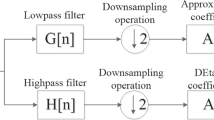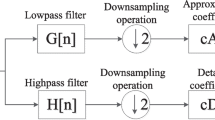Abstract
The integrity of the digital image content is very important for special types of images. To better locate tampered regions in the image, this paper proposes a reversible watermarking technology for tamper localization based on SIFT. By dividing the original image into blocks, the feature information of each sub-block is computed as the authentication watermark. The carrier image is then processed to extract the feature region of the image, and the authentication watermark generated by each sub-block is embedded into the corresponding feature region through mapping. When the watermarked image is attacked, the related attack is detected by the invariant moment, and the sub-block feature value and the authentication watermark extracted from the feature region are calculated to determine if the sub-block has been tampered with, and if so, the position of the tampered region is given. The experimental result illustrates this scheme can detect and locate the tamper region effectively and accurately, and the scheme has certain robustness and invisibility.
















Similar content being viewed by others
Data availability
All relevant data are within the paper.
References
Ansari IA, Pant M, Ahn CW (2015) Svd based fragile watermarking scheme for tamper localization and self-recovery [J]. Int J Mach Learn Cybern 7(6):1225–1239
Chiang KH, Chien KCC, Chang RF et al (2008) Tamper detection and restoring system for medical images using wavelet- based reversible data embedding [J]. J Digit Imaging 21(1):77–90
Dadkhah S, Manaf AA, Hori Y et al (2014) An effective svd-based image tampering detection and self-recovery using active watermarking [J]. Signal Process Image Commun 29(10):1197–1210
Fang Y, Liu J, Li J et al (2022) Robust zero-watermarking algorithm for medical images based on SIFT and Bandelet-DCT [J]. Multimed Tools Appl 81(12):16863–16879
Farid H (2009) Exposing digital forgeries from JPEG ghosts [J]. IEEE Trans Inform Forens Secur 4(1):154–116
Gao GY, Cui ZM, Zhou CX (2018) Blind reversible authentication based on PEE and CS reconstruction [J]. IEEE Signal Process Lett 25(7):1099–1103
Gong X, Chen L, Yu F et al (2020) A Secure image authentication scheme based on dual fragile watermark [J]. Multimed Tools Appl 79(25):18071–18088
Gul E, Ozturk S (2019) A novel hash function based fragile watermarking method for image integrity [J]. Multimed Tools Appl 78(13):17701–17718
Gull S, Loan NA, Parah SA et al (2020) An efficient watermarking scheme for tamper detection and localization of medical images [J]. J Ambient Intell Humaniz Comput 11(5):1799–1808
Hong W, Chen M, Chen TS (2017) An efficient reversible image authentication method using improved PVO and LSB substitution techniques [J]. Signal Process Image Commun 58:111–122
Huo Y, He H, Chen F (2014) A semi-fragile image watermarking algorithm with two-stage detection [J]. Multimed Tools Appl 72(1):123–149
Hu YC, Choo KKR, Chen WL (2017) Tamper detection and image recovery for BTC-compressed images [J]. Multimed Tools Appl 76(14):15435–15463
Li CL, Wand YH, Ma B et al (2012) Tamper detection and self-recovery of biometric images using salient region-based authentication watermarking scheme [J]. Comput Stand Interf 34(4):367–379
Lin CC, Huang Y, Tai WL (2017) A novel hybrid image authentication scheme based on absolute moment block truncation coding [J]. Multimed Tools Appl 76(1):463–488
Nasir NH, Shabir AP, Nazir AL et al (2019) Dual watermarking framework for privacy protection and content authentication of multimedia [J]. Futur Gener Comput Syst 94:654–673
Nazari M, Sharif A, Mollaeefar M (2017) An improved method for digital image fragile watermarking based on chaotic maps [J]. Multimed Tools Appl 76(15):16107–16123
Pal P, Jana B, Bhaumik J (2019) Watermarking scheme using local binary pattern for image authentication and tamper detection through dual image [J]. Security and Privacy 2(2):e59
Pasad S, Pal AK (2020) A Tamper detection suitable fragile watermarking scheme based on novel payload embedding strategy [J]. Multimed Tools Appl 79(3):1673–1705
Phadikar A, Maity SP, Mandal M (2012) Novel wavelet- based QIM data hiding technique for tamper detection and correction of digital images [J]. J Vis Commun Image Represent 23(3):454–466
Raj NRN, Shreelekshmi R (2021) A survey on fragile watermarking based image authentication schemes [J]. Multimed Tools Appl 80:19307–19333
Sahu AK (2022) A logistic map based blind and fragile watermarking for tamper detection and localization in images [J]. J Ambient Intell Humaniz Comput 13:3869–3881
Sahu AK, Sahu M, Patro P et al (2022) Dual image-based reversible fragile watermarking scheme for tamper detection and localization [J]. Pattern Anal Applic 26(2):571–590
Sahu AK, Hassaballah M, Rao RS et al (2023) Logistic-map based fragile image watermarking scheme for tamper detection and localization [J]. Multimed Tools Appl 82:24069–24100
Singh D, Singh SK (2016) Effective self-embedding watermarking scheme for image tampered detection and localization with recovery capability [J]. J Vis Commun Image Represent 38(4):775–789
Su GD, Chang CC, Chen CC (2021) A hybrid-Sudoku based fragile watermarking scheme for image tampering detection [J]. Multimed Tools Appl 80(8):12881–12903
Swaraja K, Meenakshi K, Padmavathi K (2021) An optimized blind dual medical image watermarking framework for tamper localization and content authentication in secured telemedicine [J]. Biomed Signal Process Control 55(2):1–15
Trivedy S, Pal AK (2017) A logistic map-based fragile watermarking scheme of digital images with tamper detection. Iranian J Sci Technol Trans Electric Eng 41(2):103–113
Xiang YP, Xiao D, Wan H et al (2019) A secure image tampering detection and selfrecovery scheme using POB number system over cloud [J]. Signal Process 162:282–295
Zhang ZW, Li FF, Zuo XY et al (2023) Reversible image watermarking algorithm based on reverse histogram translation [J]. Multimed Tools Appl 82:11005–11019
Zhang ZW, Wu LF, Gao SB et al (2018) Robust reversible watermarking algorithm based on RIWT and compressed sensing [J]. Arab J Sci Eng 43:979–992
Zhang ZW, Wu LF, Yan YY et al (2017) An improved reversible image watermarking algorithm based on difference expansion [J]. Intl J Distrib Sensor Netw 13(1):1–15
Acknowledgements
This work is supported by National Statistical Science Research Project (2018LY12). At the same time this work is also supported by the Opening Project of GuangDong Province Key Laboratory of Information Security Technology (2020B1212060078).
Author information
Authors and Affiliations
Corresponding author
Ethics declarations
Competing interests
The authors declare that they have no competing interests.
Additional information
Publisher’s Note
Springer Nature remains neutral with regard to jurisdictional claims in published maps and institutional affiliations.
Rights and permissions
Springer Nature or its licensor (e.g. a society or other partner) holds exclusive rights to this article under a publishing agreement with the author(s) or other rightsholder(s); author self-archiving of the accepted manuscript version of this article is solely governed by the terms of such publishing agreement and applicable law.
About this article
Cite this article
Zhang, Z., Xiao, W., Liu, T. et al. A reversible image watermarking algorithm for tamper detection based on SIFT. Multimed Tools Appl 83, 34647–34668 (2024). https://doi.org/10.1007/s11042-023-16976-5
Received:
Revised:
Accepted:
Published:
Issue Date:
DOI: https://doi.org/10.1007/s11042-023-16976-5




